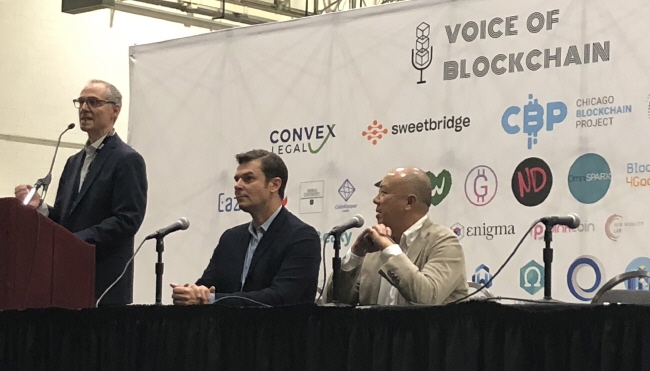
The future of currency looks increasingly invisible—and branded .
Bitcoin is going through something of an identity crisis. While much
The recent focus on
I had the privilege of getting back to bitcoin’s payment roots by moderating a conversation on the Future of Currency at the Voice of Blockchain conference, held Aug. 24-25 in Chicago. Edmund Moy, a former director of the United States Mint, and Matthew Roszak, investor
Mainstream cryptocurrency adoption
What intrigued me most was how a former director of the U.S. Mint, serving 2006-2011, through main thrust of the financial crisis, got interested in bitcoin. “I looked at bitcoin and crypto basically to returning currency to where it all began, before governments got involved,” Moy said.
His conservative Republican, free-market viewpoint fit perfectly with the traditionally Libertarian views of hard-core bitcoin evangelists. They also fit well with the more traditional investors, traders, consultants, and bankers who also spoke at and attended the show.
I asked Moy and Roszak what they thought about the interest central bankers are taking in digital currencies, as they realize digital currencies can provide greater control over the money supply. “It would be a massive game changer. . . an important stepping stone in terms of the long-term adoption curve,” Roszak said.

Future of Currency panel at Voice of Blockchain (Lexy Prodromos photo)
Countries where fiat currencies hold little value (Venezuela, Argentina, Zimbabwe to name a few) are more ripe for mainstream adoption than major countries like the United States. “Here in the United States, we have currency options that work. They may be expensive, they may be inefficient, they may be monopolistic, but they work,” Moy said.
Cryptopayments technology needs work as well, Roszak said. “We’re still in the earliest of days. There’s a ton of work to make this technology easier to use, to make it invisible.”
Invisible, instant, and free
The U.S. payments system as a whole faces the same problem, as it runs up against the technology expectations of consumers and businesses.
“We are used to
Bitcoin evangelists use the same terms for the cryptocurrency, which has the advantages of instant and free but hardly invisible. Invisible presupposes easy to use, and BTC payments are not exactly easy to use.
In the short term, Moy said, “more people will experience crypto through branded coins and closed economies than they will through bitcoin.”
As if to prove the point, FinTech and identity consultant David Birch posted an article Aug. 30 on an announcement by Starbucks widely reported as the international coffee emporium’s decision to accept bitcoin payments through an exchange built in partnership with Microsoft. It is not.
“What was actually being announced was, essentially, a plan to find a way of loading Starbucks wallets from bitcoin accounts,” Birch writes.
In other words, it’s a way to make bitcoin payments invisible by embedding them in the widely used Starbucks app, as Uber is so famous for doing with credit cards.
Regulatory schizophrenia
One of the main themes I came to appreciate at both the blockchain conference and open-banking panel is the increasing need for clear regulatory guidance. It’s necessary for existing financial institutions to remain competitive by embracing the democratic ideals behind data sharing (open banking) and decentralized currencies (bitcoin).
“With that regulatory guidance, comes permission,” said Ben Schack, who heads U.S. digital partnerships for BMO Harris, Chicago. He spoke at the Accenture open banking panel.
Not surprisingly, the status of bitcoin from both a state and federal regulatory perspective is as schizophrenic as its media perceptions. Its use as a currency is hampered as a result.
“Until crypto is taxed like a currency, where you are paying sales tax, it will be challenging to have it work like a currency,” said Colleen Sullivan, partner and CEO in CMT Digital Holdings, Chicago. She spoke on the institutional investor panel at Voice of Blockchain.
Regulatory clarity is not only needed but inevitable. “We will see greater and greater government involvement,” Moy noted. “It’s incumbent on this nascent industry to be engaged with government, as government will end up determining the operating environment you’re going to face.”
